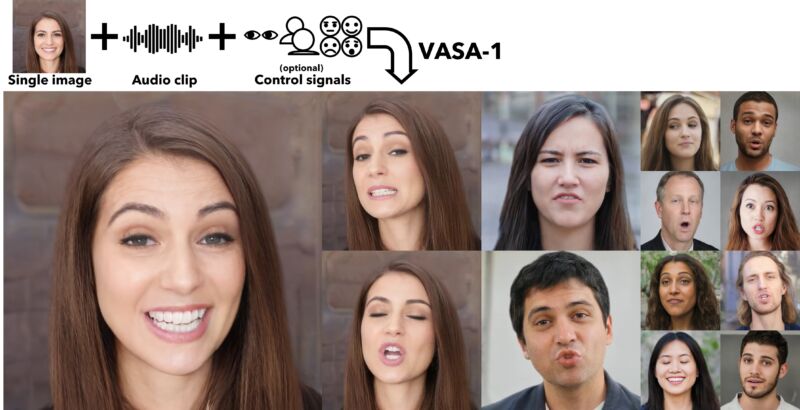[ad_1]

Generated in Actual Time.”
On Tuesday, Microsoft Analysis Asia unveiled VASA-1, an AI mannequin that may create a synchronized animated video of an individual speaking or singing from a single picture and an current audio monitor. Sooner or later, it might energy digital avatars that render regionally and do not require video feeds—or permit anybody with related instruments to take a photograph of an individual discovered on-line and make them seem to say no matter they need.
“It paves the best way for real-time engagements with lifelike avatars that emulate human conversational behaviors,” reads the summary of the accompanying analysis paper titled, “VASA-1: Lifelike Audio-Pushed Speaking Faces Generated in Actual Time.” It is the work of Sicheng Xu, Guojun Chen, Yu-Xiao Guo, Jiaolong Yang, Chong Li, Zhenyu Zang, Yizhong Zhang, Xin Tong, and Baining Guo.
The VASA framework (quick for “Visible Affective Expertise Animator”) makes use of machine studying to investigate a static picture together with a speech audio clip. It’s then capable of generate a practical video with exact facial expressions, head actions, and lip-syncing to the audio. It doesn’t clone or simulate voices (like different Microsoft analysis) however depends on an current audio enter that may very well be specifically recorded or spoken for a selected function.
Microsoft claims the mannequin considerably outperforms earlier speech animation strategies by way of realism, expressiveness, and effectivity. To our eyes, it does appear to be an enchancment over single-image animating fashions which have come earlier than.
AI analysis efforts to animate a single picture of an individual or character prolong again at the very least a couple of years, however extra just lately, researchers have been engaged on routinely synchronizing a generated video to an audio monitor. In February, an AI mannequin referred to as EMO: Emote Portrait Alive from Alibaba’s Institute for Clever Computing analysis group made waves with the same method to VASA-1 that may routinely sync an animated picture to a offered audio monitor (they name it “Audio2Video”).
Skilled on YouTube clips
Microsoft Researchers skilled VASA-1 on the VoxCeleb2 dataset created in 2018 by three researchers from the College of Oxford. That dataset incorporates “over 1 million utterances for six,112 celebrities,” based on the VoxCeleb2 web site, extracted from movies uploaded to YouTube. VASA-1 can reportedly generate movies of 512×512 pixel decision at as much as 40 frames per second with minimal latency, which suggests it might doubtlessly be used for realtime functions like video conferencing.
To point out off the mannequin, Microsoft created a VASA-1 analysis web page that includes many pattern movies of the device in motion, together with folks singing and talking in sync with pre-recorded audio tracks. They present how the mannequin may be managed to precise completely different moods or change its eye gaze. The examples additionally embrace some extra fanciful generations, comparable to Mona Lisa rapping to an audio monitor of Anne Hathaway performing a “Paparazzi” tune on Conan O’Brien.
The researchers say that, for privateness causes, every instance picture on their web page was AI-generated by StyleGAN2 or DALL-E 3 (other than the Mona Lisa). However it’s apparent that the approach might equally apply to images of actual folks as nicely, though it is possible that it’s going to work higher if an individual seems much like a celeb current within the coaching dataset. Nonetheless, the researchers say that deepfaking actual people will not be their intention.
“We’re exploring visible affective ability technology for digital, interactive charactors [sic], NOT impersonating any individual in the actual world. That is solely a analysis demonstration and there is not any product or API launch plan,” reads the location.
Whereas the Microsoft researchers tout potential constructive functions like enhancing academic fairness, enhancing accessibility, and offering therapeutic companionship, the expertise might additionally simply be misused. For instance, it might permit folks to pretend video chats, make actual folks seem to say issues they by no means truly stated (particularly when paired with a cloned voice monitor), or permit harassment from a single social media picture.
Proper now, the generated video nonetheless appears imperfect in some methods, however it may very well be pretty convincing for some folks if they didn’t know to count on an AI-generated animation. The researchers say they’re conscious of this, which is why they don’t seem to be overtly releasing the code that powers the mannequin.
“We’re against any habits to create deceptive or dangerous contents of actual individuals, and are concerned about making use of our approach for advancing forgery detection,” write the researchers. “Presently, the movies generated by this technique nonetheless comprise identifiable artifacts, and the numerical evaluation exhibits that there is nonetheless a spot to attain the authenticity of actual movies.”
VASA-1 is just a analysis demonstration, however Microsoft is much from the one group growing related expertise. If the latest historical past of generative AI is any information, it is doubtlessly solely a matter of time earlier than related expertise turns into open supply and freely obtainable—and they’ll very possible proceed to enhance in realism over time.
[ad_2]




